Over two dozen CURE members joined and supported the MNi Sota Nibi Walk from the headwaters at Big Stone Lake in Ortonville to the confluence at Fort Snelling on Pike Island. The 330 mile walk began on March 25th and concluded on Friday, April 1st. Water was taken from the headwaters and carried the entire length of the river in a copper vessel, and when the walkers reached the end of the walk, the water was poured back in to the river. In essence, it is a way for the river to know what the water was like when it started at the headwaters.
“In the spiritual work of the Anishinaabe (Ojibwe) people, the women are responsible for the water,” said Sharon Day, Ojibwe Elder. Day has taken that responsibility to heart and educates and engages people all across the country in learning more about our water ways and overall health of the water. She has led walks on the Mississippi River, St. Louis River and the Ohio River as well as all around Lake Superior.
Participation in this walk was significant for several reasons. First, it provided an opportunity for CURE members to support the Ojibwe and Dakota people on this walk. Secondly, members were able to walk the landscape along the river and see firsthand the problems with land management and contamination.
Following the opportunity to walk, Michael Jacobs of Easy Bean Farm shared his thoughts, “The water is relatively clean at its source but, by the time it reaches the Mississippi, it has collected waters from countless farm fields and ditches and is full of sediment, nutrients and farm chemicals. Walking through my own neighborhood gave me a good chance to reflect more deeply on the way that water, that which should be so very precious to us, is treated so poorly in our community and how the two great blessings of ample water and beautiful soil are turned into curses for those downstream due to our continued neglect.”
Near the Upper Sioux Agency State Park, several of the walkers witnessed a landowner who allowed his cattle to walk freely in the river. This was a common sight in other areas of the watershed as well. If for no other reason, it was a firsthand look at various land and animal management practices that contribute to the contamination and erosion that impacts the Minnesota River.

Special thanks to the following CURE members: Robin Moore, Michelle Thelen, Audrey Arner, Richard Handeen, Kylene Olson, Mike Jacobs, Malena Handeen, Misty Neyens, Alice Menge, Don Robertson, Teresa, Hunter and Walker Peterson, Autumn Cavender-Wilson, Scott and Dacian DeMuth, Scott Tedrick, Mary Erler Peters, Carrie Jennings, Steve, Reena, Jesse and Leena Petrich, Sarah Wolbert and Gary Lentz for joining the Nibi Walk.
Blog post and photos by Peg Furshong, Operations and Program Director.






